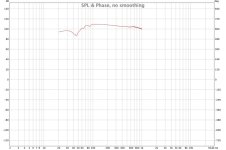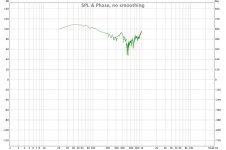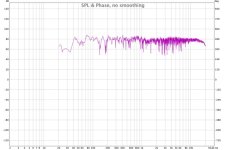in nearfield measurement
With a true nearfield measurement (microphone within about 0.25" of the cone), I would not expect a measurement like that (for several reasons). Exactly what was your setup? Speaker location, microphone distance from speaker, gating, etc.the large bump at 60 hz is 3,5 db the dip from 70 to 180 hz average 1,5 db
And did you adjust the port based on impedance or a nearfield acoustic measurement of it? Or something else?
Measurement was taken from a single speaker in the middle of the room, distance from microphone was 1mt, the 5 cm port was initially adjusted to a lenght of 15 cm (this was the length specified in the project) but after I tried 16, 13, and 10 cm with some differences in the SPL but little differences reguarding problems
I would put golden brick bullion or two inside. Its innert, does not oxidize or rot, and its heavy to stabilize crappy enclosure, and increases the value too...the story in brief: I have a pair of speakers that I call "Satori Frankestein" with SB satori MW16p-8 + SB satori TW29R, the cabinet is that of Jeff Bagby's Kairos but I'm testing the crossover of Joachim G's Kalasan 5. Having difficulty to obtain a smooth low end, I want to experiment with a lower volume of the cabinet, however since it does not have openable sides and that the internal surfaces are covered with felt, the operation is not so simple and reversible, I thought I would try it by inserting some volumes of polystyrene between the sides of the cabinet (equivalent to about 3 liters) but I wonder if the polystyrene is dense enough for this purpose and also if fixing it only by interlock could have a bad influence on the result
Attachments
The bump at 60Hz looks a little too narrow. I'd be trying to ascertain whether it's a room mode. Low frequency measurements are usually done by sweeping the mic or averaging multiple placements, or could simply be improved by moving the speaker around.
whether it's a room mode
Given the measure protocol everything below 2-300 Hz is suspected room response.
dave
Measure real near field. Microphone one inch or less from the cone. Repeat that on the port. Correct for surface and phase and add both responses (sim apps do that fine too). You were measuring the room, not the speaker.Thank you Allen tomorrow I will try measurement in another room
Even higher in a smaller space, like a car. I guess for that matter it's just luck that these are frequencies where we can do things like apply multiple subs without being sensitive to the technique.Given the measure protocol everything below 2-300 Hz is suspected room response.
According to my calculations, for a 17 liter enclosure and 5 cm inside diameter port:the 5 cm port was initially adjusted to a lenght of 15 cm (this was the length specified in the project) but after I tried 16, 13, and 10 cm with some differences in the SPL but little differences reguarding problems
10 cm length = 49 Hz Fb
13 cm = 44.5 Hz
15 cm = 42.1 Hz
16 cm = 41.1 Hz
So three of your tested lengths were relatively close to each other in expected performance. The above values are just calculations. This is often followed up with confirmatory measurements of some kind to ensure that things are behaving as expected.
I did my homework... I put the loudspeaker in the middle of my living room and took some more and hopefully better measurements: 1)20-1000 Hz one inch from the midwoofer 2)20-1000 hz one inch from the port (now set to 13 cm) 3)20-20000 of the speaker from 1 mt
Attachments
Even with the wrong scale it's clear that the level decreases some 5-6dB between 100Hz and 700Hz. The big 2m4H series coil could contribute to that. Combine it with some reinforcement from nearby boundaries (what is the listening setup?) and I would suggest a change in the baffle step correction. This doesn't seem a low frequency tuning problem to me, more a setup and crossover issue.
Take my comment as that of an inexperienced DIYer: yes midwoofer has a declining trend in that area but this is not so obvious from 1 mt measurement The inductor is 2,2mH 0,18ohm, for the sweeps I have used a calibrated Umik-1 the RME ADI2-DAC and a LFD zero mk3 integrated amp
Moreover all this taught me how much I have to learn about measurements in the environment .....😒
Try outside.Moreover all this taught me how much I have to learn about measurements in the environment .....😒
- Home
- Loudspeakers
- Multi-Way
- How to lower the internal volume of an already finished eclosure



